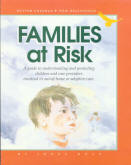Substance abuse is the cited as one of the top problem areas. Of confirmed cases of child maltreatment 40% involve the use of alcohol or other drugs in the US. This suggests nationally that of the 1.2 million confirmed cases an estimated 480,000 children are mistreated each year by a caretaker with alcohol or drug problems. Additional research suggests that alcohol or drug problems are factors in a majority of cases of emotional abuse and neglect. Prenatal exposure to alcohol, drugs or malnutrition complicates childhood development and growth and parenting these children is very difficult. Special needs adoptive parents, foster and kinship caregivers are at significant risk. Other areas of concern
involved:
Minnesotas Foster Children
|
| 1996 1995 1994 1993 |
8 9 7 6 |
The
death of one child at the hands of a caregiver is tragic.
Thirty children
died in Minnesota at the hand of a caregiver during 1993-1996.
Another 72
children were identified as having life threatening injuries.
-
 99% of the time children
were victimized by family members or those responsible for their care.
99% of the time children
were victimized by family members or those responsible for their care. -
What is known about Minnesota
perpetrators in 1996?- 99% are victimized by family members and those most frequently in charge of their care
- 80% Birth Parents
- 13% Other Relatives
- 5% Parent Companions
- 1% Foster Parents, Facility Staff, Child Care Providers
- 1% Other Non-Relatives or unknown
Abuse in Day Care/Foster Care creates a good deal of public and media attention. Such publicity has created the perception that it is common place. This perception is out of place with reality. In 1996, reports of abuse in institution, foster and day care represent 3% nationally.
 Life Is Unfair!
Life Is Unfair!
Say it!
It's OK! Say
it Again.
Bad Things Do Happen to Good People!
Get Families at Risk a 416 page guidebook to
help you and your family through these complex times.
No matter how bad your heart
is broken
the world doesn't
stop for your grief.
Workshops available for Agencies and Associations
Foster Families, Adoptive Parents and Kinship Caregivers
Brief
insight into our workshop program
This site is provided complements of Better
Endings New Beginnings.
It is not intended to convey legal, educational, medical or professional advice.
We recommend you find your own local professional who can work with you.
|




 Minnesota's
Breakdown of Statistics
Minnesota's
Breakdown of Statistics
